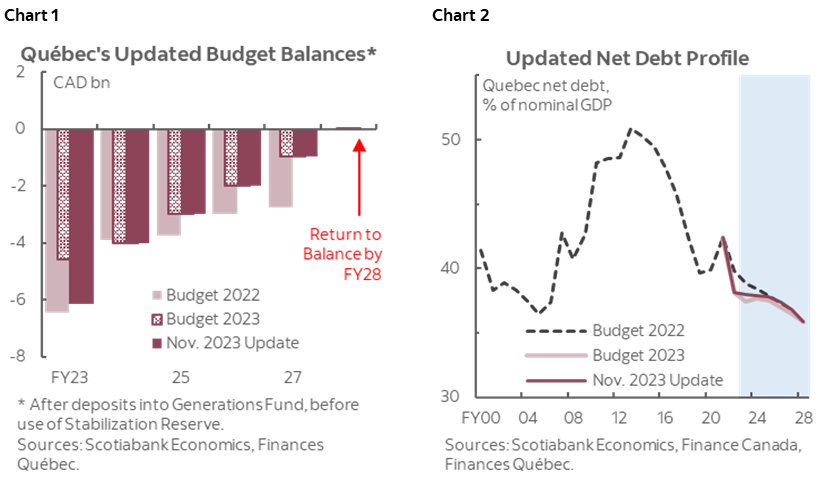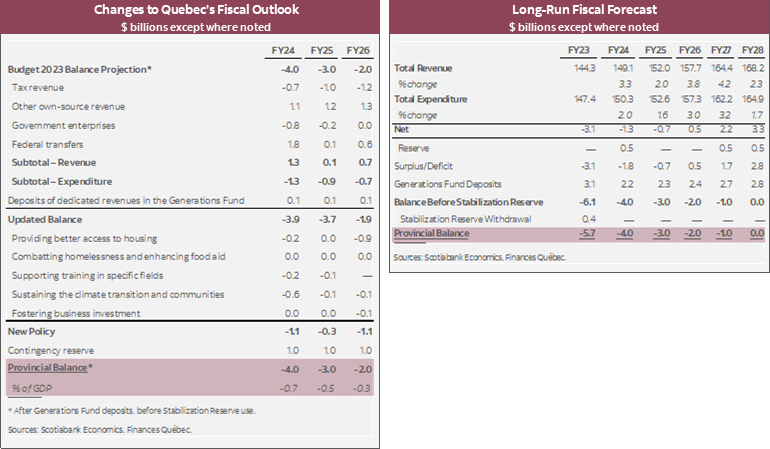BALANCING ACT 2.0: PATH TO BALANCE INTACT AS NEW SPENDING ERODES FINANCIAL BUFFER
- Budget balance projections: -$4.0 bn (-0.7% of nominal GDP) in FY24, -$3.0 bn (-0.5%) in FY25 (all figures after deposits into Generations Fund)—in line with Budget 2023 projections; deficit projected to be gradually eliminated at a rate of $1 bn per year until the return to balance targeted for FY28 (chart 1).
- Net debt forecasts: expected to decline gradually from 38% of nominal output in FY23 to 35.9% by FY28—a hair above the path outlined in Budget 2023 (chart 2).
- Economic forecasts: real GDP forecast unchanged at 0.6% for 2023 but reduced from 1.4% to 0.7% for 2024; nominal GDP projection raised to 4.0% for 2023 and nudged down to 3.4% for 2024.
- New policy measures: $1.6 bn in FY24, $2.2 mn in FY25, and $3.1 bn in FY26—combined $13 bn over FY24–28 (averaging 0.4% of projected nominal GDP per year over the forecast horizon), two-thirds of which is the indexation of the personal income tax system and social assistance benefits. Other key measures target housing, climate transition and business investment.
- Downward adjustments in the contingency reserve by $1 bn per year offset costs of new policy actions, keeping the projected consolidation path intact.
- Financing program: estimated at $21.9 bn in FY24—$7.6 bn lower than March 2023 forecast; medium-term borrowing projection remains stable at $29.0 bn in FY25 and $28.7 bn in FY26.
- We are encouraged by the government’s continued commitment to achieve a balanced book by FY28 but note with caution downside risks from an optimistic growth forecast and the reduction of financial buffer. The indexation of the personal income tax system—another major reform in Quebec’s tax system commeasurable with the tax cut delivered in Budget 2023—provides welcomed support to the lower end of the income spectrum but the timing could add immediate inflationary pressures. Other policy measures appear relatively contained and position the province for sustained competitiveness in the future.

OUR TAKE
Quebec presented its FY24 mid-year amid a year marked by a more pronounced economic slowdown than the national average, persistent inflation, and an outlook clouded by heightened uncertainty. The province found itself in a weaker fiscal position than previously anticipated, with the FY23 deficit, previously projected at -$5.0 bn, rising to -$6.1 bn (before use of the stabilization reserve) based on a weaker revenue outlook and lifted program spending. However, the consolidation path remains similar to the one outlined in Budget 2023, with new policy actions funded by a yearly drawdown of $1 bn from the contingency reserve over the planning horizon. Before Generations Fund deposits, Quebec still expects to balance in FY26.
The updated economic projections are largely in line with private-sector averages in real terms but slightly more optimistic than our current view, leaving the potential for downside risks. Nominal GDP assumptions underpinning the updated fiscal plan are above both the private-sector averages and our projections through 2023 and 2024. Every 1 ppt in nominal GDP growth is linked with $1 bn in own-source revenues—on this basis, the nominal output growth forecast of 4.0% this year—0.9 ppts above the private-sector average—could be expected to subtract -$0.9 bn (0.2% of nominal output) from the bottom line. The update presented an alternative scenario that forecasts a recession in 2024 with Quebec’s economy contracting by -0.8%. The potential fiscal impact of the alternative scenario is estimated at -$127 mn in FY24, -$1.7 bn in FY25, and -$0.8 bn in FY26.
Before accounting for new policy actions, fiscal impact from changes in the economic and budgetary situation since Budget 2023 is minimal. Revenue projection remains largely intact but the composition has changed. The province expects tax revenue to be close to $1 bn lower in the next three years, offset by higher federal transfers and higher miscellaneous revenue from health and education services. Portfolio spending projections were revised higher by around $800 mn per year over FY24–FY26 due to the higher cost of refundable tax credits, combined with higher-than-anticipated activities in health and education expenditures. Debt-service costs saw a $401 mn (4%) uptick in FY24, adding to near-term spending pressure. To sum up, the fiscal impact on the province’s bottom line from changes in the economic and budgetary situation is estimated at $104 mn in FY24, -$747 mn in FY25 and $94 mn in FY26.
The government is pledging several new policy initiatives, totalling $12.9 bn (0.4% of nominal GDP), with $1.6 bn added to this fiscal year and $2–3 bn per year over FY25–FY28. New policy initiatives target cost of living, housing, homelessness, adaptation to climate change and business investment. The lion’s share of the new measures is the $2 bn per year in indexation of the personal income tax system and social assistance benefits. The modernization of the tax system provides more relief to low- and medium-income households—known to be the most impacted by price inflation—but could also add some tailwind to inflation. Other targeted actions are dominated by the $1.8 bn housing investment over five years, aiming to build 8,000 social and affordable housing units in the province. The update also dedicates $649 mn in FY24 in response to the forest fires and to support climate change adaptation, as well as public transit. To boost business investment, the province is renewing the investment and innovation tax credit (C3i), with gradually escalating costs reaching $590 mn by FY28. Other than the tax changes, policy actions look appropriately targeted but unlikely to generate a significant boost to near-term economic growth.
The annual drawdown of $1 bn from the contingency reserve enables the province to keep its consolidation path, albeit at the cost of diminishing its capacity to buffer against downside risks. The updated plan retains a $500 mn contingency reserve in FY24, leaving no provision over FY25–FY26. Hence, we could anticipate further downward revisions to the medium-term bottom line, particularly in light of heightened uncertainties surrounding the economic and inflation outlook.
In line with the largely unchanged deficit profile, the province’s net debt-to-GDP ratio remains on a similar downward path as the one outlined in Budget 2023. Quebec’s debt as a share of output came in higher in FY23 at 38% instead of the 37.4% anticipated at budget time, and is expected to remain largely flat till FY25 before gradually declining to 35.9% in FY28. A recession could lead to a temporary uptick in the province’s net debt-to-GDP ratio in FY25 at 38.7%—0.9 ppts higher than in the baseline scenario. The government has a long-term debt reduction strategy, which aims to reduce net debt to 30% of nominal output by FY38 (with a ±2.5% interval) and a median-term target of 33% of GDP by FY33.
The province’s financing program scaled back by $7.6 bn for FY24 with outer years projections largely stable relative to Budget 2023. The province now expects to borrow $21.9 bn in FY24, $29.0 bn in FY25, $28.7 bn in FY26, $25.3 bn in FY27, and $21.9 bn in FY28. The $7.6 bn reduction in FY24 financing needs is the combination of lower net financial requirements ($4.1 bn), the use of pre-financing ($2.2 bn), and an increase in the amount of Quebec Treasury bills outstanding ($2 bn). Among the $18.6 bn borrowing completed to date in FY24, 39% of borrowing had been conducted on foreign markets—higher than the 27% average in the prior 10 years. The province also issued a $600 mn green bond this fiscal year under its Green Bond program, for a total of nine issues totalling $5.7 bn since the program was launched.

DISCLAIMER
This report has been prepared by Scotiabank Economics as a resource for the clients of Scotiabank. Opinions, estimates and projections contained herein are our own as of the date hereof and are subject to change without notice. The information and opinions contained herein have been compiled or arrived at from sources believed reliable but no representation or warranty, express or implied, is made as to their accuracy or completeness. Neither Scotiabank nor any of its officers, directors, partners, employees or affiliates accepts any liability whatsoever for any direct or consequential loss arising from any use of this report or its contents.
These reports are provided to you for informational purposes only. This report is not, and is not constructed as, an offer to sell or solicitation of any offer to buy any financial instrument, nor shall this report be construed as an opinion as to whether you should enter into any swap or trading strategy involving a swap or any other transaction. The information contained in this report is not intended to be, and does not constitute, a recommendation of a swap or trading strategy involving a swap within the meaning of U.S. Commodity Futures Trading Commission Regulation 23.434 and Appendix A thereto. This material is not intended to be individually tailored to your needs or characteristics and should not be viewed as a “call to action” or suggestion that you enter into a swap or trading strategy involving a swap or any other transaction. Scotiabank may engage in transactions in a manner inconsistent with the views discussed this report and may have positions, or be in the process of acquiring or disposing of positions, referred to in this report.
Scotiabank, its affiliates and any of their respective officers, directors and employees may from time to time take positions in currencies, act as managers, co-managers or underwriters of a public offering or act as principals or agents, deal in, own or act as market makers or advisors, brokers or commercial and/or investment bankers in relation to securities or related derivatives. As a result of these actions, Scotiabank may receive remuneration. All Scotiabank products and services are subject to the terms of applicable agreements and local regulations. Officers, directors and employees of Scotiabank and its affiliates may serve as directors of corporations.
Any securities discussed in this report may not be suitable for all investors. Scotiabank recommends that investors independently evaluate any issuer and security discussed in this report, and consult with any advisors they deem necessary prior to making any investment.
This report and all information, opinions and conclusions contained in it are protected by copyright. This information may not be reproduced without the prior express written consent of Scotiabank.
™ Trademark of The Bank of Nova Scotia. Used under license, where applicable.
Scotiabank, together with “Global Banking and Markets”, is a marketing name for the global corporate and investment banking and capital markets businesses of The Bank of Nova Scotia and certain of its affiliates in the countries where they operate, including; Scotiabank Europe plc; Scotiabank (Ireland) Designated Activity Company; Scotiabank Inverlat S.A., Institución de Banca Múltiple, Grupo Financiero Scotiabank Inverlat, Scotia Inverlat Casa de Bolsa, S.A. de C.V., Grupo Financiero Scotiabank Inverlat, Scotia Inverlat Derivados S.A. de C.V. – all members of the Scotiabank group and authorized users of the Scotiabank mark. The Bank of Nova Scotia is incorporated in Canada with limited liability and is authorised and regulated by the Office of the Superintendent of Financial Institutions Canada. The Bank of Nova Scotia is authorized by the UK Prudential Regulation Authority and is subject to regulation by the UK Financial Conduct Authority and limited regulation by the UK Prudential Regulation Authority. Details about the extent of The Bank of Nova Scotia's regulation by the UK Prudential Regulation Authority are available from us on request. Scotiabank Europe plc is authorized by the UK Prudential Regulation Authority and regulated by the UK Financial Conduct Authority and the UK Prudential Regulation Authority.
Scotiabank Inverlat, S.A., Scotia Inverlat Casa de Bolsa, S.A. de C.V, Grupo Financiero Scotiabank Inverlat, and Scotia Inverlat Derivados, S.A. de C.V., are each authorized and regulated by the Mexican financial authorities.
Not all products and services are offered in all jurisdictions. Services described are available in jurisdictions where permitted by law.

